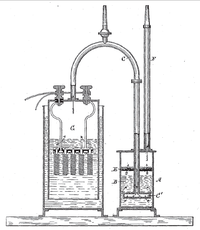
Photo from wikipedia
L-cystine (LC) was employed as an additive to inhibit crystallization of V(II) or V(III) specie in the negative electrolyte and extend the practical application of vanadium redox flow battery (VRFB)… Click to show full abstract
L-cystine (LC) was employed as an additive to inhibit crystallization of V(II) or V(III) specie in the negative electrolyte and extend the practical application of vanadium redox flow battery (VRFB) at below-ambient temperatures. UV–Vis spectrometry showed LC has no effect on the absorption in the range of 300–800 nm. Crossover testing indicated that LC can permeate from negative side to positive side across the membrane Nafion 117. Static thermal stability testing showed LC can significantly inhibit precipitation of V(II)~V(IV) ions or V(V) in 1.8 M vanadium electrolyte with 3.0 M H2SO4 at 5 or 50 °C. It is found that 2–4 wt% LC in vanadium electrolytes can lower viscosity compared to the blank electrolyte. Cyclic voltammetry (CV) and electrochemical impedance spectroscopy (EIS) show V(III) electrolyte with 2 wt% LC exhibits superior electrochemical activity and diffusion coefficient, compared with the pristine electrolyte. VRFB single-cell tests operating at 5 and 50 °C were investigated. LC can inhibit the capacity decay and voltage efficiency loss at below-ambient temperatures. VRFB with LC obtains better performance of higher capacity retention (93.14 vs. 92.21%) and energy efficiency (73.36 vs. 68.66%) than the pristine at 5 °C.
Journal Title: Ionics
Year Published: 2018
Link to full text (if available)
Share on Social Media: Sign Up to like & get
recommendations!